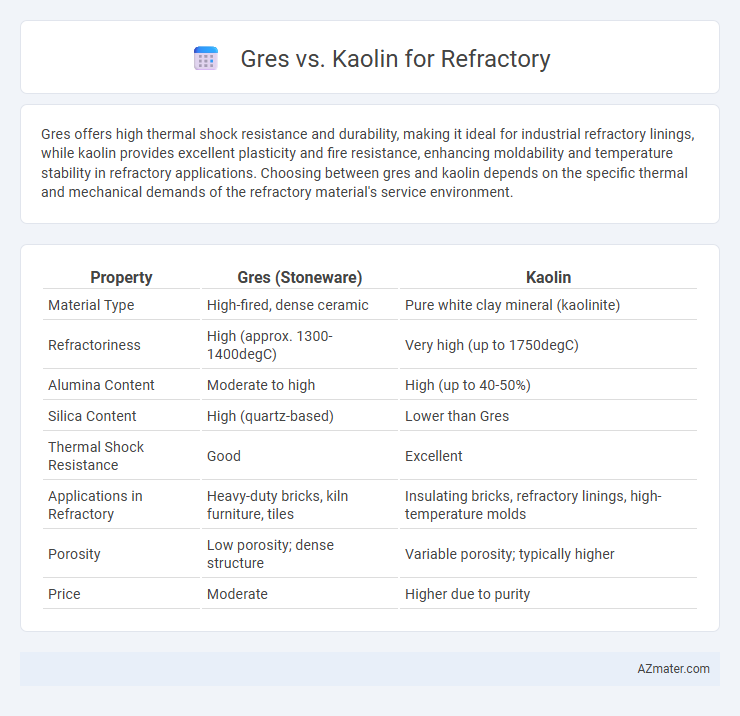Gres offers high thermal shock resistance and durability, making it ideal for industrial refractory linings, while kaolin provides excellent plasticity and fire resistance, enhancing moldability and temperature stability in refractory applications. Choosing between gres and kaolin depends on the specific thermal and mechanical demands of the refractory material's service environment.
Table of Comparison
| Property | Gres (Stoneware) | Kaolin |
|---|---|---|
| Material Type | High-fired, dense ceramic | Pure white clay mineral (kaolinite) |
| Refractoriness | High (approx. 1300-1400degC) | Very high (up to 1750degC) |
| Alumina Content | Moderate to high | High (up to 40-50%) |
| Silica Content | High (quartz-based) | Lower than Gres |
| Thermal Shock Resistance | Good | Excellent |
| Applications in Refractory | Heavy-duty bricks, kiln furniture, tiles | Insulating bricks, refractory linings, high-temperature molds |
| Porosity | Low porosity; dense structure | Variable porosity; typically higher |
| Price | Moderate | Higher due to purity |
Introduction to Gres and Kaolin in Refractory Applications
Gres and kaolin are essential raw materials in refractory applications, valued for their high thermal stability and resistance to chemical corrosion. Gres, a type of dense, vitrified ceramic, provides excellent mechanical strength and thermal shock resistance, making it ideal for furnace linings and kiln furniture. Kaolin, a fine white clay rich in alumina and silica, enhances fire resistance and acts as a binder in refractory shapes, improving durability and insulating properties.
Key Properties of Gres for Refractory Use
Gres, known for its high-fired density and low porosity, exhibits excellent thermal shock resistance and mechanical strength, making it ideal for refractory applications. Its low thermal expansion coefficient ensures dimensional stability under extreme heat, enhancing durability in furnaces and kilns. Compared to kaolin, gres offers superior abrasion resistance and chemical inertness, crucial for maintaining integrity in aggressive high-temperature environments.
Essential Characteristics of Kaolin in Refractory Materials
Kaolin is prized in refractory applications for its high alumina content, excellent thermal stability, and resistance to chemical corrosion, which are critical for durability in high-temperature environments. Its fine particle size and plasticity ensure superior moldability and mechanical strength in shaped refractory products. Unlike gres, kaolin offers enhanced refractory performance characterized by low thermal expansion and high fusion point, making it indispensable in furnace linings and kiln furniture.
Thermal Performance: Gres vs Kaolin
Gres offers excellent thermal shock resistance and higher thermal conductivity, making it suitable for applications requiring rapid heating and cooling cycles. Kaolin provides superior thermal insulation due to its lower thermal conductivity and high refractory strength, ideal for maintaining stable high-temperature environments. The choice between gres and kaolin depends on the specific thermal performance requirements of the refractory application.
Chemical Resistance Comparison: Gres and Kaolin
Gres exhibits superior chemical resistance in refractory applications due to its high silica and alumina content, which enhances durability against slags and acidic slags. Kaolin, composed primarily of alumina and silica, offers moderate chemical resistance but tends to degrade faster in harsh acidic or basic environments compared to Gres. The crystallinity and mineral composition of Gres provide better thermal stability and corrosion resistance, making it more suitable for aggressive refractory conditions.
Mechanical Strength Analysis: Gres vs Kaolin
Gres exhibits superior mechanical strength compared to kaolin in refractory applications due to its higher firing temperature and denser microstructure, which enhances resistance to thermal shock and abrasion. Kaolin, while offering good plasticity and alumina content, generally has lower mechanical strength, making it less suitable for high-stress refractory linings. Mechanical strength analysis shows gres refractories maintain integrity under high load and temperature cycling, outperforming kaolin-based counterparts in industrial furnaces and kilns.
Cost-effectiveness: Gres or Kaolin for Refractory?
Gres offers cost-effective advantages in refractory applications due to its lower raw material and processing costs compared to kaolin, making it suitable for high-volume industrial uses. Kaolin, while more expensive, provides superior thermal stability and chemical resistance, which can reduce long-term maintenance and replacement expenses in demanding refractory environments. Choosing between gres and kaolin depends on balancing upfront material costs against performance requirements to achieve optimal cost-effectiveness in refractory manufacturing.
Common Industrial Applications of Gres and Kaolin
Gres, also known as stoneware, is widely used in refractory lining for furnaces and kilns due to its high thermal shock resistance and durability under extreme temperatures. Kaolin, a white clay mineral, is essential in producing refractory bricks, insulating mortars, and ceramic fiber products because of its excellent alumina and silica content that withstands high heat. Industries like steel manufacturing, glass production, and cement plants rely on both materials to enhance furnace efficiency, prolong service life, and maintain structural integrity at elevated temperatures.
Environmental Impact: Gres vs Kaolin in Refractories
Gres and kaolin exhibit distinct environmental impacts in refractory applications, with kaolin often requiring more intensive mining and processing, resulting in higher energy consumption and carbon emissions. Gres, typically derived from natural stone clays, tends to have a lower ecological footprint due to less aggressive extraction methods and reduced chemical treatment. Sustainable refractory production increasingly favors gres for its comparatively minimal environmental degradation and efficient resource utilization.
Choosing the Right Material: Gres or Kaolin?
Choosing between Gres and Kaolin for refractory applications depends on specific thermal and chemical resistance requirements. Gres offers high mechanical strength and thermal shock resistance, making it suitable for environments with rapid temperature changes. Kaolin excels in refractory linings due to its superior purity and high alumina content, providing excellent resistance to slag and molten metal corrosion.

Infographic: Gres vs Kaolin for Refractory
 azmater.com
azmater.com